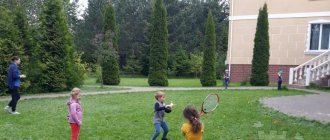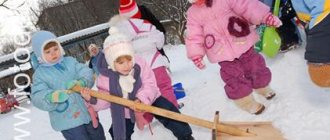Organization of a walk. Themed walks with preschoolers. article on the topic
Organization of a walk. Themed walks with preschoolers.
In the educational process, an important element in the daily routine is walking with children. The main task of the teacher when conducting walks is to provide active, meaningful, varied and interesting activities for children.
Traditionally, a walk includes such components as organizing children’s observations of natural phenomena (flora and fauna, inanimate nature); various games; work activity; sports exercises and independent activities of children according to their choice and interests. In this case, it is necessary to provide for a uniform alternation of calm and motor activity, distribution of physical activity during the entire walk.
To ensure that walks are varied and interesting for children, educators plan their content daily, including both the educational component and the children’s independent activities. Independent and joint activities with peers presuppose the availability of a variety of playing materials and equipment, the creation of various flexible subject-based play tools in the kindergarten area.
When planning a walk, the teacher must take into account many factors: weather conditions, the age of the children and their cognitive interests, available material, the topic of the previous lesson. It is necessary to provide for the possibility of a healing effect not only physically, but also mentally. For a child’s body, a properly organized walk can be the most accessible means of hardening.
The basic requirements that must be observed when organizing walks are defined in the relevant regulatory documents.
The joint activity of an adult with children during a walk is especially pronounced, since it is here that the child closely communicates with the teacher in all types of activities.
For a child, the educational process makes sense if it is built in the logic of activity. Therefore, the educational component of a walk is always connected with any type of children’s activity (play, communication, work, motor, cognitive-research, musical-art, productive) without its strict regulation.
It is clear that the leading play activity, through which the child learns about the world and organically develops, has a special role during a walk. Game forms of education can be in an individual, subgroup or frontal form of organizing work with students. Motor activity during a walk is combined with play, but at the same time the teacher is obliged to regulate the load by monitoring the condition of the children.
Modern requirements for updating the educational process suggest making walks as diverse as possible in content and organization.
In the methodological literature and individual regulatory documents, one can find confirmation that in addition to the traditional structure of walks with children that have developed over the years, thematic walks can be held, built on the principle of dominance of the type of children's activity or that are a continuation of the theme of the day in the educational process.
The authors of the guide “Themed Walks in Kindergarten” offer five types of themed walks:
walks and hikes;
entertaining walks with a character;
walk-events;
sports walks;
walks are labor actions.
Hiking is an organized type of activity, during which health-improving tasks are solved, motor skills and physical qualities of children are improved, their cognitive needs are satisfied, and love and aesthetic attitude towards nature are fostered. They should be carried out with children of older preschool age. The optimal number of such walks is 2-3 per year. We believe that if these walks are carried out frequently, they will lose their attractiveness and children’s interest in them will decrease.
Entertaining walks with the character are aimed at emotional and psychological relief for children, creating a positive emotional background, and satisfying children’s needs for physical activity. The forms of their organization can be diverse and variable, since they depend not only on the goals and objectives set, but also on the thematic focus and semantic richness.
Walking with a character is good for motivating children for a certain type of activity; the character helps to interest all the children in the group, attract them to joint play activities, observation, and work.
Walk-events are dedicated to a specific theme (Cosmonautics Day, Defender of the Fatherland Day, Victory Day, City Day, Knowledge Day, etc.) or an event that occurred in kindergarten (a new play complex was brought and installed, sports equipment was updated, sand was updated in the sandboxes, etc. .).
An event walk (thematic walk) helps the teacher once again draw children’s attention to an important event, clarify their knowledge and perception of a certain topic.
Sports walks are aimed at improving health, preventing fatigue, physical and mental development, and optimizing the physical activity of children. In sports walks, various types of children's activities are united by a sports theme.
When properly organized, these walks have a hardening effect on the body in natural conditions. They help increase the level of physical fitness of preschool children. The emphasis in such walks is on the formation of physical qualities, nurturing interest in sports and a healthy lifestyle.
These walks promote mental, moral, aesthetic education and develop the curiosity of preschoolers.
In walks and labor actions, labor assignments for children predominate, including them in forms of work that are different in organization in accordance with the season and weather conditions.
On walks associated with work activities, children develop an understanding that work in nature is not a game or entertainment, but a serious activity. The teacher brings them to an understanding of the need for such work, fosters a desire to participate in the work of caring for plants, feeding birds, and cleaning the area (raking snow, cleaning the veranda from sand and leaves).
On such walks, children learn to work in a team, together. The result of labor is the result of the joint work of everyone.
Bibliography:
- K.Yu. Belaya, E.A. Karalashvili, L.I. Pavlova and others. Themed walks in kindergarten. M.: Perspective, 2013
Organization of a walk in a preschool educational institution
A walk is a mandatory part of the daily routine in a preschool educational institution (DOU).
In order to protect the life and health of children, the teacher and junior teacher at the beginning of the working day (before accepting children) carefully inspect the entire territory: for broken equipment, broken glass, unwanted objects, plants, etc.
The teacher prepares for a walk in the same way as for a lesson (thinks through and plans the organization of the activity and its feasibility).
The walk has a preparatory stage, consisting of the following steps: Preparing the teacher for the walk; Dressing children for a walk.
An important point in organizing a walk is getting the children dressed and going out to the playground. Each group needs a spacious locker room with individual lockers and enough benches and chairs so that the child can sit comfortably and put on socks or shoes without disturbing other children. But even in this case, it is necessary to seek help from adults.
The teacher must teach children to dress and undress independently and in a certain order. First everyone puts on socks, leggings and shoes, then a sweater, jacket, hat, scarf and mittens. When they return from a walk, they undress in reverse order. When children have developed the skills of dressing and undressing and do it quickly and accurately, the teacher helps only occasionally (fastening buttons, tying a scarf, etc.). It is necessary to teach children to help each other, and not to forget to thank for the service provided.
Practice shows that dressing time is 8-12 minutes; if it exceeds 15-25 minutes, it means that the skills have not been developed and children need to be taught to dress faster. Using various techniques: play, competition, motivation, but in no case comparison with a child, punishment, condemnation, insult.
The participation of an assistant teacher in preparing children for the hike is mandatory in each age group. It is unacceptable for her to be busy with other things at this moment, since it is difficult for the teacher alone to take care of dressing all the children, helping the slow ones and bringing the entire group to the square on time. As soon as some of the children get dressed, so as not to keep them indoors, the teacher goes with them to the playground, and the rest continue to get dressed under the supervision of an assistant, who later takes them out for a walk.
Proper organization of a walk involves the use of outdoor and sports games, physical exercises, observations, labor, independent activities, etc., and the effectiveness of the implementation of all components of the walk depends entirely on the teacher. If the walk is well and properly organized, if it is long enough, children will realize about 50% of their daily need for active movement. By reducing the time spent in the air, a lack of movement occurs.
The individual characteristics of students are most clearly manifested in independent activities. Some children prefer quiet games and can be occupied with them throughout the entire walk, while others are constantly on the move. The teacher must remember that the most favorable state of the physiological systems of the body is provided by a uniform load, a combination of different intensities of movements; in the last 8-10 minutes of the walk it is better to engage in quiet games, put away toys, and tidy up the territory.
Children should not be allowed to walk in one position for a long time. It is necessary to switch them to other activities and change the place of play. It is important that the child is in a state of thermal comfort throughout the entire walk. To do this, clothes and shoes must be comfortable and appropriate for the weather. It is necessary to carry out more information and educational work with parents. Clothing should be comfortable and made from natural fabrics, three layers for temperatures from +3 to -3, four layers for -4 to -10, and a winter coat with four layers of clothing is recommended for -11 to -15. At temperatures below -18 - -22 degrees, the walking time is reduced.
Even a colorfully decorated area will arouse children's interest and desire to go for a walk. In addition to playgrounds, covered gazebos are needed on the territory to protect children from rain and sun.
Features of development of young children
- The rapid pace of development, which requires timely influences, necessary changes in the conditions of education;
- Discontinuity in the development of basic functions (alternating periods of retardation with critical periods);
- Rapid establishment of connections with the outside world and slow consolidation of reactions, which requires repetition in training;
- Unevenness (heterochrony) of maturation of brain structures and functions, abilities, skills, control over the development of pathways;
- High vulnerability, lability of the nervous system, protection of the child’s nervous system;
- The relationship between the state of physical health, mental development and behavior of the child;
- High brain plasticity, ease of learning, high sensorimotor needs of the child.
During this period, such intensive brain development occurs that does not occur in any subsequent period of life. At 7 months, the size of a child’s brain doubles, at 1.5 years it triples, and at the age of 3 years it already accounts for 3/4 of the mass of an adult’s brain. During this sensitive period, the foundations of intelligence, thinking, high mental activity, and a variety of language skills are laid. This is the age when everything is for the first time, everything is just beginning - language, play, communication with peers, first ideas about yourself, about others, about the world. In the first three years of life, the most important and basic human abilities are formed - cognitive activity, curiosity, self-confidence and trust in others, concentration and perseverance, imagination, creativity and many others. Moreover, all these abilities do not arise on their own as a result of the child’s young age, but require the indispensable participation of an adult and age-appropriate forms of activity. L.S. Vygodsky said: “Mental development occurs in the process of assimilation and acquisition of socio-historical experience.”
Infancy is a time of significant change in a young child's life. First of all, the child begins to walk. During the second year of life, the child masters walking. Walking is a great achievement of mankind, only man masters walking and this shows the development of the human brain. Having the ability to move independently, he experiences a huge space, independently comes into contact with a mass of objects that previously often remained inaccessible to him.
Sensory needs cause a high level of motor activity, and movement is a baby’s natural state that contributes to his intellectual development. Thanks to this liberation, the child’s dependence on the adult decreases, and cognitive activity develops quickly.
In the second year of life, the child develops objective activity, and in the third year of life, objective activity becomes leading. At the age of three years, the dominant hand is determined and coordination of both hands begins to form.
With the emergence of object-based activity, which is based on mastering those ways of operating with an object that ensure its use for its intended purpose, the child’s attitude towards surrounding objects and the nature of orientation changes. Instead of asking “What is this?” When meeting a new object, the child already has the question “What to do with this?” (R.Ya. Lekhtman-Abramovich, D.B. Elkonin).
The child's cognitive interest expands enormously, so he strives to learn more objects and toys and act with them. The development of the child’s perception is closely related to the development of object actions, since in the process of actions with objects the child learns not only how to use them, but also their properties - shape, size, color, mass, material, etc.
Children develop simple forms of visual and effective thinking, the most primary generalizations that relate directly to the assignment of certain external and internal characteristics of objects.




